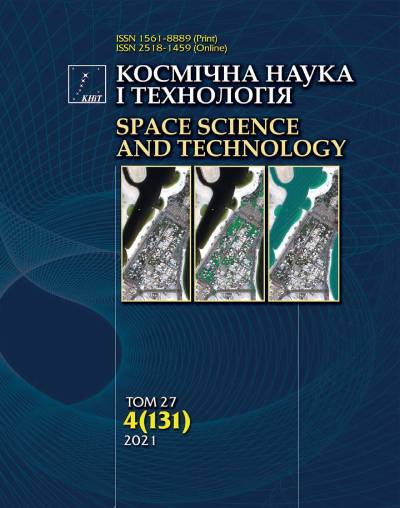Creating a microgreen growing environment at the space station
DOI:
https://doi.org/10.15407/knit2021.04.065Keywords:
microgreen in hydrogel, microgreen planting, planting in space stationAbstract
Plants are essential types of human nutrition, both in terrestrial and in space station conditions. The cultivation of plant foods in space conditions at the near-Earth stations has become possible due to the modern achievements in agricultural technologies. The proposed article aims to study the creation of optimal conditions for growing plants used in human nutrition in the space stations. In the work, a selection of plants and soil types for space station conditions was made. For this purpose, a three-stage experiment was carried out. In the first experiment, an experimental method was exploited to select the types of plants that are most suitable for growing under extreme conditions. The composition and structure of the soil were determined experimentally. It is shown that hydrogel can be used to accumulate water in space station conditions and can be a suitable medium for growing plants. Studies have shown that just hydrogel (without any nutrient mixtures) can promote plant growth. At the second stage of research, plants were successfully grown on the mixture of the hydrogel and the soil. In the third experiment, the authors added biostimulants and organic products to the hydrogel, and as a result, there was an increase in the speed and stability of plant growth. The experimental prototype of the container for growing plants in space conditions, which was tested in the above experiments, created by the authors, is shown.
References
Ahmed E. M. (2015). Hydrogel: Preparation, characterization, and applications: A review. Adv. Res., 6, No 2, 105—121.
https://doi.org/10.1016/j.jare.2013.07.006
Berkovich Y. A., Krivobok N. M., Sinyak Y. Y., Smolyanina S. O., Grigoriev Y. I., Romanov S. Y., Guissenberg A. S. (2004). Developing a vitamin greenhouse for the life support system of the international space station and for future interplanetary missions. Adv. Space Res., 34, No 7, 1552—1557.
https://doi.org/10.1016/j.asr.2004.06.006
Dutcher F. R., Hess E. L., Halstead T. W. (1994). Progress in plant research in space. Adv. Space Res., 14, No 8, 159—171.
https://doi.org/10.1016/0273-1177(94)90400-6
Erohin A. N. (2006). Optimizacia sistemi osveshenia rastenii dlia konveiernoi cilindricheskoi salatnoi oranjerei kak komponenta SJO pilotiruemogo kosmicheskogo korablia: Autoref. kand. diss. Мoscow.
Hangarter R. P. (1997). Gravity, light and plant form. Plant, cell & environment, 20, No 6, 796—800.
https://doi.org/10.1046/j.1365-3040.1997.d01-124.x
Hoson T., Kamisaka S., Masuda Y., Yamashita M (1992). Changes in plant growth processes under microgravity conditions simulated by a three-dimensional clinostat. The botanical magazine= Shokubutsu-gaku-zasshi, 105, No 1, 53—70.
https://doi.org/10.1007/BF02489403
Kazemi F., Mohorko R. (2017). Review on the roles and effects of growing media on plant performance in green roofs in world climates. Urban Forestry & Urban Greening, 23, 13—26.
https://doi.org/10.1016/j.ufug.2017.02.006
Kordyum E. L. (1997). Biology of plant cells in microgravity and under clinostating. Int. Rev. Cytol., 171, 1—78.
https://doi.org/10.1016/S0074-7696(08)62585-1
Lai Y. H. A., Howe A. S. (2003). A kit-of-parts approach to pressure vessels for planetary surface construction. AIAA Space 2003 Conference & Exposition, Р. 6281.
https://doi.org/10.2514/6.2003-6281
Mammarella M., Vernicari P. M., Paissoni C. A., Viola N. (2019). How the Lunar Space Tug can support the cislunar station. Acta astronaut, 154, 181—194.
https://doi.org/10.1016/j.actaastro.2018.04.032
Massa G. D., Dufour N. F., Carver J. A., Hummerick M. E., Wheeler R. M., Morrow R. C., Smith T. M. (2017). VEG-01: Veggie hardware validation testing on the International Space Station. Open Agriculture, 2, No 1, 33—41.
https://doi.org/10.1515/opag-2017-0003
Massa G. D., Newsham G., Hummerick M. E., Morrow R. C., Wheeler R. M. (2017). Plant pillow preparation for the veggie plant growth system on the international space station. Gravitational and Space Res., 5, No 1.
https://doi.org/10.2478/gsr-2017-0002
Massa G. D., Wheeler R. M., Morrow R. C., Levine H. G. (2016). Growth chambers on the International Space Station for large plants. VIII International Symposium on Light in Horticulture 1134, 215––222.
https://doi.org/10.17660/ActaHortic.2016.1134.29
Montesano F. F., Parente A., Santamaria P., Sannino A., Serio F. (2015). Biodegradable superabsorbent hydrogel increaseswater retention properties of growing media and plant growth. Agriculture and agricultural science procedia, 4, 451—458.
https://doi.org/10.1016/j.aaspro.2015.03.052
Nelson M. (1997). Growing Super-Dwarf wheat in space station MIR. Life Support & Biosphere Sci, 4, No 3-4, 155—166.
Novikova N., De Boever P., Poddubko S., Deshevaya E., Polikarpov N., Rakova N., ... , Mergeay M. (2006). Survey of environmental biocontamination on board the International Space Station. Res. microbiology, 157, No 1, 5—12.
https://doi.org/10.1016/j.resmic.2005.07.010
Prince R. P., Knott III W. M. (1989). CELSS breadboard project at the Kennedy Space Center.
Samsonov N. M., Bobe L. S., Gavrilov L. I., Novikov V. M., Farafonov N. S., Grigoriev J. I., ... , Sinjak J. E. (2000). Long-duration space mission regenerative life support. Acta astronaut, 47, No 2-9, 129—138.
https://doi.org/10.1016/S0094-5765(00)00052-7
Seedhouse E. (2012). The Birth of the World’s First Commercial Astronaut Agency. Astronauts for Hire. Boston, MA: Springer.
https://doi.org/10.1007/978-1-4614-0520-7
Singh A., Sharma P. K., Garg V. K., Garg G. (2010). Hydrogels: A review. Int. J. Pharm Sci. Rev. Res., 4, No 2, 016.
Wheeler R. M. (2017). Agriculture for space: people and places paving the way. Open agriculture, 2, No 1, 14—32.
https://doi.org/10.1515/opag-2017-0002
Zheng H. Q., Han F., Le J. (2015). Higher plants in space: microgravity perception, response, and adaptation. Microgravity Sci. and Techn., 27, No 6, 377—386.


